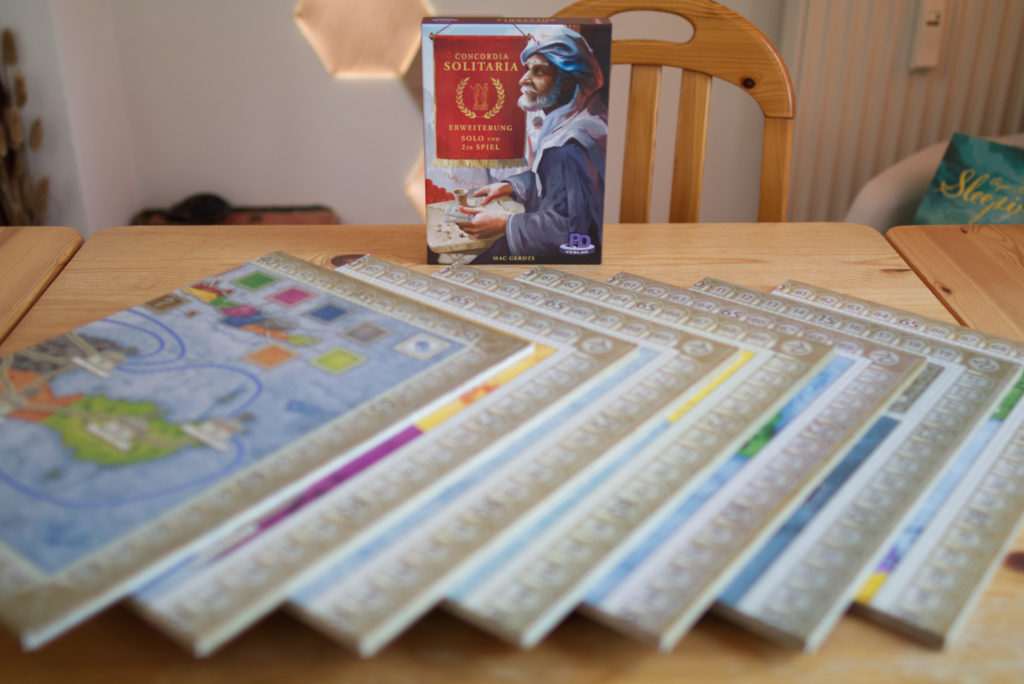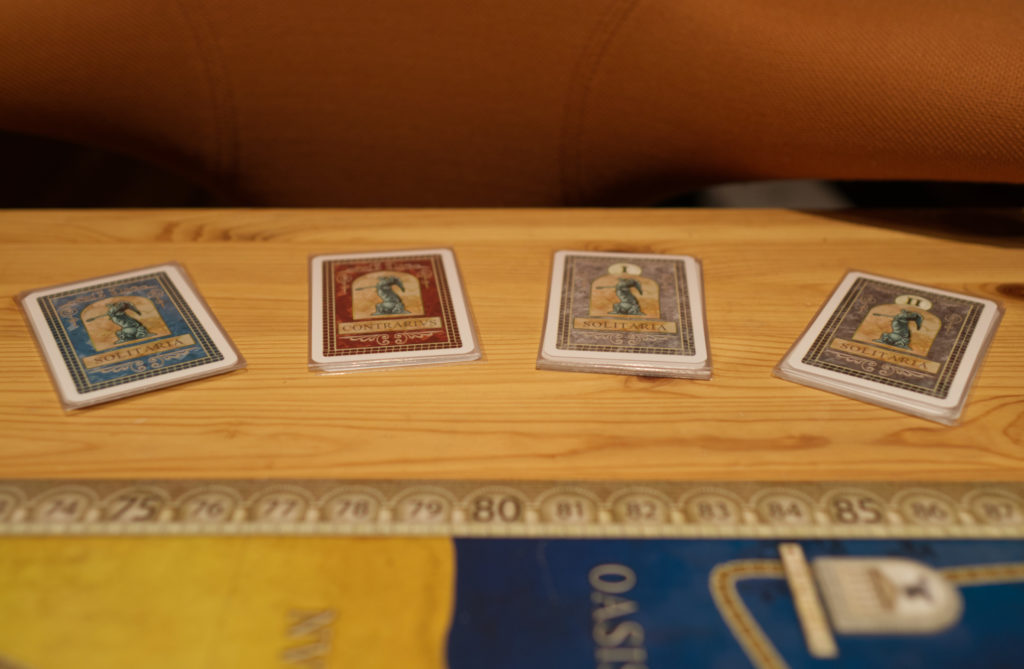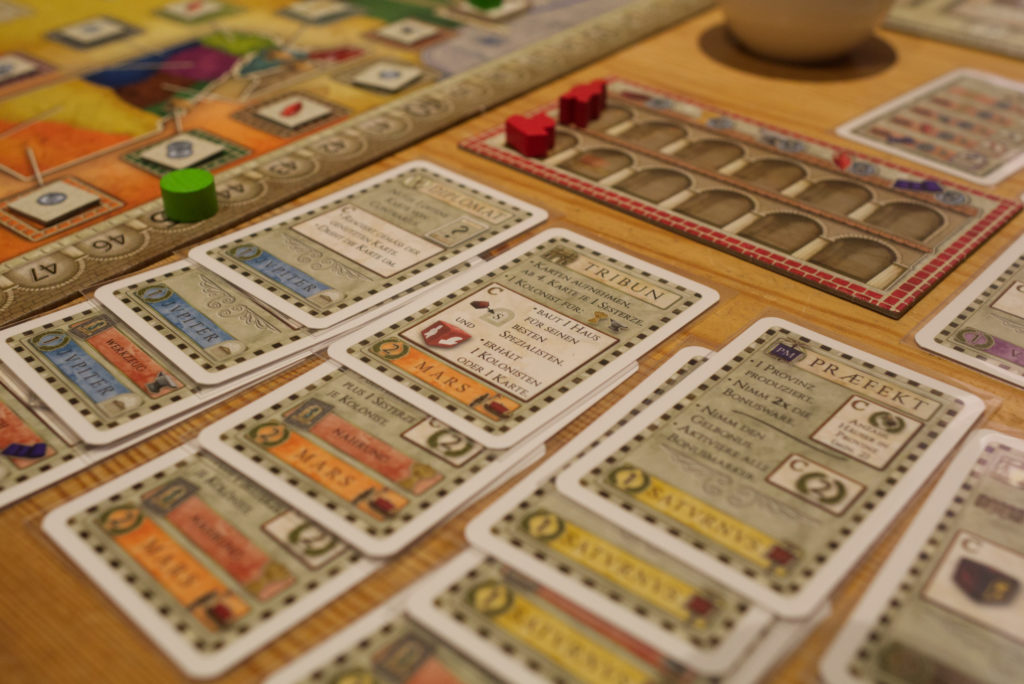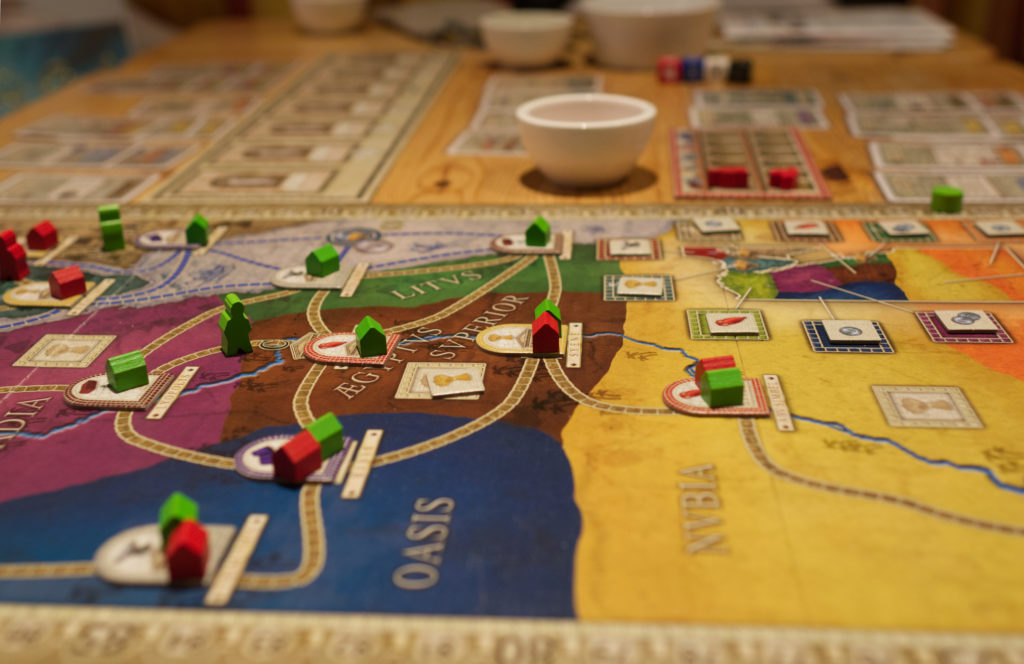In the last couple of years, automa design has made great advancements. From simple cleanup/blocker-automas that more or less at random remove tiles from the board or block action spaces without much intent (e.g. Messina 1347) to pace makers with intent (e.g. Jean in Maracaibo), from priority-automas that try to find the first of their desires that is achievable to automas that actively try to get you fired … I’m looking at you, Kanban EV. As varied as the types of automas are, the personal taste in automa also has become more differentiated. Some people like them really plain and simple while others ravel in giant flow charts. So let’s take a step back and look at what an “ideal” automa would have to achieve:
- play the same game as you: a lot of automa designs abstract away resource demands (e.g. the automa does not have to pay money), either for ease of use or because an automa that has full resource constraints and still manages to play well is very difficult to do. But a number of solo modes have the automa play what almost amounts to a different game. The automa in Red Rising for examples ignores all card effects (arguably the primary mechanism of the game).
- “feel” like a human player: this one is difficult to quantify, but ideally the way you as a human play and have to react on the automa’s actions would be the same as in a multi-player game.
- have low overhead: if executing an automa turn is too complex, it stalls the game flow and you might loose track of your own strategy.
- help you learn the game or get better at it: after my first game of Brass: Lancashire, I failed hard to get a grasp of what I am supposed to do or what the start of a strategy might be. Mauro’s automa and the ability to have multiple plays in quick succession were the one thing that kept me from hating it and turned it into a game I enjoy now quite a bit.
- have a win condition: sorry, but beat your own score is a cop out in my book. The score you achieve in a game is typically not only dependent on your strategy but also on the initial board state and random events. Therefore taking the VP of a past game for judging your performance in a current one (with completely different setup/events) makes absolutely no sense if you ask me.
- be interesting even in repeated play: some automas are hard in the beginning but once you figure out their flaw, they become boring. The automa of Maracaibo for example is very well done and I enjoyed it a lot for the first ten plays or so. But by the end of the campaign, I knew exactly what I had to do to block it and the challenge was gone.
- support usage as a third player: this seems to be a more recent development, but I really enjoy spicing up 2 player games with a third actor like in Dune: Imperium.
- …
To not make this list unnecessarily long, lets just agree on one thing: good automa design is hard, really hard! Enter Concordia: Solitaria. Let’s take a look at what it does and how it does it. Note: Concordia: Solitaria can be used in multiple modes. The following will focus on the standard 1 player mode, other modes will be discussed later on.

Setup
Setup is pretty quick. Instead of the normal decks and player starting cards, Concordia: Solitaria comes with a special deck containing your starting hand, Contrarius’ (the name of the automa) hand and a I and II deck. Place Contrarius’ cards side by side face up next to the board. These – as well as any card Contrarius gets during the game – are potential targets when you play a diplomat yourself. So instead of having a single top-of-the-deck card that you can copy from Contrarius, you have a choice which card to copy. However, it will be flipped over and is therefore one-time use only. The I and II decks are shuffled separately as in normal Concordia and then the market row is filled up. The only difference here is that the first specialist card (e.g. a mason, farmer) that is revealed automatically becomes another starting card of Contrarius. That’s pretty much it. Contrarius doesn’t use resources or money and therefore doesn’t need a warehouse.

The only thing that is left is for you to pick one of the three difficulty levels. In Veteran mode for example, you as the human player start with 10VP but Contrarius “goes first” and places a house on the most valuable city that is adjacent to the starting city and places his colonists on connections. This already heats up the game because typically the best spot is thus occupied when you start your first turn. As someone who has played Concordia a lot but not excessively, I like Veteran mode. If you are starting out with Concordia, Standard mode will probably be more to your liking and if you like it tough, choose Expert. Without exact numbers, I would say I have a 70% chance of winning in Veteran which typically requires enough head scratching for my taste. Expert it’s more like 30-40%.
The Turn
The party piece of Concordia: Solitaria is its clever action mechanism. You as the human player play as usual: pick one of your available cards, perform the action (e.g. build with the architect, trade with the Mercator). There are no changes here. The clever bit is that the automa’s action is printed on your card and thus you trigger what action Contrarius will perform. If you build, you know he will buy a card. If you buy cards, you know he will build a house. If you produce in a region, you know he will get victory points. However, it is not all deterministic. You may know that he will build a house, but you don’t know where and what type. In the box, you’ll find four custom dice that are used to as part of the various reactions. One of these dice – the white one – is for example used when Contrarius builds due to the senator or consul actions. You role it and it indicates the type of city he wants to build in. Then there are a handful of priorities that you follow to figure out which one he chooses. For example, Contrarius likes to build in empty cities and prefers building in a new province to building in province he already has a house in. During the first 1-2 plays, it takes a bit to get used to them. However, they quickly become second nature and it typically takes me only a few seconds to figure out which city is meant. The important bit to remember is that Contrarius is still limited by having to be able to move a colonist to the spot he wants to build, just like a human player.

The result of this mechanism is quite astonishing: you can optimize your action sequence to minimize the risk Contrarius picks up a card you desperately want by avoiding those actions until you are ready to buy. However, the price of that may be more than it is worth to actually do so. You can either get really thinking or just focus on your stuff and see what happens. The introduction of dice constantly produces tension and “why did he have to go there”-moments, way more than you would expect from an opponent that in fact has no intent at all and doesn’t have to concern himself with resources or money.
End of Game
The game ends same as a normal play of Concordia: someone buys the last card or someone builds his/her last house. You then score based on the cards that player owns and whoever got more VP wins. That’s it. No extra rules needed.
Modes
The single player mode is definitely the core of this expansion. However, you can also use Concordia: Solitaria as a third player in a two player game – or – play 2 vs 2 against two automa (with a separate included deck). I haven’t had the chance to test team play, but I really liked the addition of a third player to an otherwise 2 player game. It not only introduces another actor but also tightens up some larger maps that would otherwise not be as suitable with just two human players. I would go so far as to recommend Concordia: Solitaria even if you never plan to play solo but play 2 player often. It’s fun and another flavour you can put into your personal Concordia mix.
Maps
Concordia includes a set of minor adjustments when playing with certain maps such as Egypt. I’ve played Solitaria with pretty much all maps by now, so here are a few recommendations: My personal favourite were Italy, Balearica, and Creta with the buying recommendation going to Balearica (it features the optional fish market and the island design is interesting). If you’re a seasoned Concordia player, you may be surprised by the choice of Italy because it is rather a 4 player map. However, I had multiple memorable situations where Contrarius royally screwed me over on this map so I like to return to it quite often.
In general, new maps are a great way to introduce new aspects in your solo play of Concordia. Before getting Solitaria, I owned the Concordia Venus base game box, Creta/Egypt and Germania/Britanni. By and by I have now bought every expansion there is for the game. The one thing I didn’t like was using Salsa with Solitaria. I had high hopes for Salsa, but since a two player game is over quite quickly and provinces aren’t producing that often, it never felt worth for me building in a salt city. The fish market also seemed easy to exploit without giving Contrarius too many points. But it’s nice to get it as a bonus to an excellent map.
Conclusion
I can sum this up pretty quickly: if you like Concordia, you will like Solitaria. If you have thought about getting Concordia but don’t have the right group for it, Solitaria is also a great way to explore the game. That’s what has happened to me. By the time I got to Concordia, my regular playing groups had already done dozens of plays and moved on to other games. So I was able to play a 2-player game here, a 3-player game there, but that was it. Solitaria opened up Concordia for me and gave me the chance to try out all the different maps and hone my skills.
As I wrote in the title, Solitaria is an almost perfect automa in my book. The mechanism is simple to administer and you can focus on figuring out your own strategy. It is challenging so you have to improve your playing style and come up with new ideas. A single game takes 30-60 min depending on how thinky you are and how complex the situation is, so just the right length to put it on the table at the end of a day and fry your brain … or play it more casual if you prefer that. If anything, I got the feeling that it is almost over a bit too quickly for my taste. I mean Concordia has always been a race, but this is tight!

So why the “almost”? I think Concordia: Solitaria succeeds on pretty much all accounts, but lacks a bit on replayability. Don’t get me wrong: you can play dozens or even hundreds of games of Concordia with it and there will always be a challenge. But it is always the exact same deck and the exact same set of building priorities. I liked the way Jean was constructed in Maracaibo with two “trait” cards which you didn’t know in the beginning and had to figure out as the match progresses. With every game, it had a slightly different strategy to which you had to adapt. Contrarius on the other hand has no strategy. He is a reaction to your action with added randomness via the dice. Sometimes, he feels very much human, scoring just the province you needed to score yourself. At other times, he feels more like a natural disaster that scours the land without purpose. Or maybe a human player that only cares about messing up your own plans half of the time.
In a weird way, that also makes the fascination of Concordia Solitaria: if you loose, it’s your fault. It’s your planning that didn’t mitigate risk correctly. If you don’t do anything, Contrarius doesn’t do anything. With a lot of automa, winning or loosing depends on the luck of the draw when it comes to the automa deck. But here, there is no automa deck. It’s your choice of action that much more influences what Contrarius does than the dice do. When I sit down to play a game of Concordia Solitaria, it’s with the knowledge that I have to bring my A-game and it depends on me alone whether I win or loose. It feels like a giant puzzle but still pure Concordia. And that is awesome.
Getting back to replayability: the answer whether or not Solitaria has replayability is the same as with the base game of Concordia. Some might argue Concordia is for the most part always the same (and thus has no replayability) while others would argue that it is infinitely replayable. I don’t think the mechanisms of Solitaria will get stale. They work and they work brilliantly. Mac Gerdts has polished and tweaked the rules of Solitaria to a level that few designers nowadays do. There is a reason why Concordia works with relatively few rules and the same is true for Solitaria. As with a good movie, we get to see the final result and can only imagine how many iterations and how much work that we will never see was put into it. I have played quite a number of sessions and I may have found some things I can exploit but I haven’t found a real weakness yet. The thing that might be missing for you is the reason to bring this back to the table after repeated play. I’ve found that getting new maps helps to add variety but I wished there were some cards that could be added to the deck to change Contrarius behaviour in unexpected ways. Or a simple legacy/story element that would pull me in and make me say “I have to play another round of this” (like the solo campaign of Anno 1800).
But that’s only a minor quibble. All-in-all, a great expansion and exceptional design work by Mac Gerdts. Concordia Solitaria is definitely in the top echelon of automas I’ve ever played and the one that is the most likely to never get old. If you like Concordia and want to play it solo or 2 player, get it!
